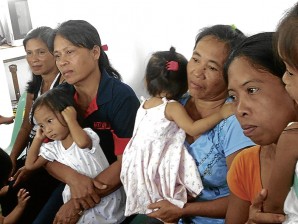
SACKS of rice arrive for distribution to Typhoon “Pablo” survivors in New Bataan, Compostela Valley, a few weeks after the storm struck in December last year. The need for more food, however, continues to grow as people who survived the storm remain jobless. MARIANNE BERMUDEZ
CATEEL, Davao Oriental—Elenita Lariba, 38, looks at her 3-year-old child Jellan and wonders when the child will eat again.
“She is not sick at all, but she hardly eats anything,” said Lariba of her child.
Weeks after Typhoon “Pablo” struck, Lariba heard doctors were coming to health clinics here. She and her child waited in line.
After a thorough screening, health workers found Jellan to be suffering from severe acute malnutrition (SAM), a hunger disease which is becoming a global concern because it can stunt growth and even cause death among young children. In the villages ravaged by Pablo, Jellan’s case is not isolated.
Three months after Pablo, health workers noted a rising number of children with acute malnutrition in most communities that have yet to recover from the devastation.
Dr. Paul Zambrano, United Nations Children’s Fund (Unicef) nutrition in emergencies officer, said that of the 20,000 children screened in four towns in Compostela Valley and three towns in Davao Oriental, over 200 were diagnosed with acute malnutrition, which ranged from the moderate to the severe. He said the number is expected to rise as the screening covers more of the 2.6 million children who were affected by Pablo, based on Unicef estimates.
Humanitarian groups have raised the alarm against the silent threat of malnutrition in these typhoon-ravaged sites. Unlike other emergencies immediately evident in times of disaster, the threat from malnutrition is hardly seen but can have a severe and long-lasting impact, said Unicef country representative Tomoo Hozumi.
“A week to 10 days after an emergency, there can be a lot of attention, but usually, people are not aware that the impact of this level of natural calamity is long-standing,” he said.
Bernadette Plaza, 46, whose 2-year-old granddaughter was also diagnosed with moderate acute malnutrition (MAM) said that after the typhoon, they have been relying on rationed food because their vegetable plots and farm animals were wiped out.
“It’s already good when we get to eat fish once a month because, right now, we are completely relying on canned goods and noodles,” she said.
“When there is a shortage of food at home, the first who get affected are women and children,” said Dr. Manuel de Lara, health project director of the international group Merlin.
In the areas of Cateel, Baganga and Mati, where Merlin has been concentrating its health emergency response, De Lara said they have monitored 20 cases of children suffering from SAM and 50 children suffering from MAM.
In the wake of Pablo, Unicef has issued a call for some $13 million in funds to carry out emergency responses for children.
Hozumi said global partners have poured in some $4.8 million but more has yet to be done.
“We did get a significant amount of funds but the level of the devastation is so big and the area so wide, and we still need to reach out to the remote areas, that there is still a need for additional resources,” Hozumi said.
Unicef is focusing its response on life-saving measures, which include education, child protection, health and nutrition and water and sanitation.
De Lara said that three months after the devastation, farmers are not yet working, mostly, on coconut plantations that had been destroyed by Pablo. People are still preoccupied with their more pressing needs and do not have the means to clear up their land for planting.
Merlin, which started its mobile clinic on Dec. 26 last year, or more than three weeks after the typhoon, discovered 22 cases of SAM and 50 cases of MAM among children six to 59 months old. “The problem is, the more we screen [children], the more we find [cases of acute malnutrition],” De Lara said.
“We’re calling it a silent emergency because it can’t be seen immediately, and it can possibly have a prolonged effect,” said Nonoy Fajardo, Unicef emergency response focal point person.
“Just because we survived the first weeks after the typhoon doesn’t necessarily mean we have gone past the crisis because there are other effects that can’t be seen immediately,” he added.
Unicef has been concentrating its emergency response in the areas of water and sanitation, nutrition, child protection and education in the towns of Compostela, New Bataan, Monkayo, Montevista in Compostela Valley and in the towns of Cateel, Boston, Baganga in Davao Oriental. Other humanitarian groups and NGOs are helping.
Daphne Oseña-Paez, Unicef special advocate for children, said among the signs of malnutrition, which mothers should always watch out for, include the swelling of hands and feet, lack of appetite and the child’s lack of interest in play.
“Once you see these signs, you should go to the health center immediately,” she said.
Jellan weighed only 8.8 kilograms when she was first diagnosed with SAM. After health workers administered the ready-to-use therapeutic food called Eezee Paste, her weight improved to 9.8 kilograms after five weeks. Her malnutrition level is now classified as moderate.